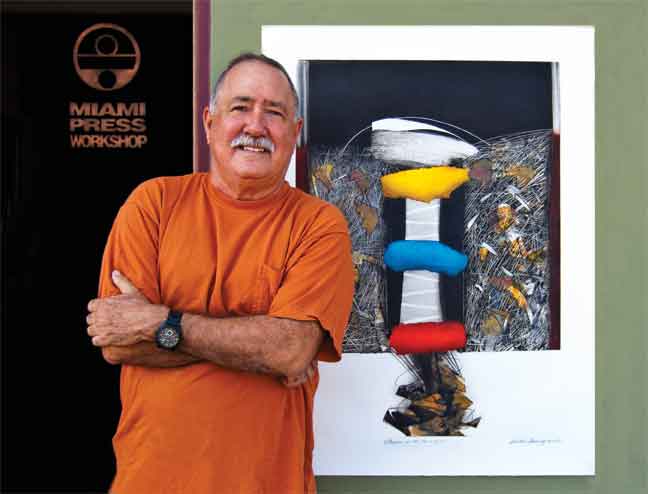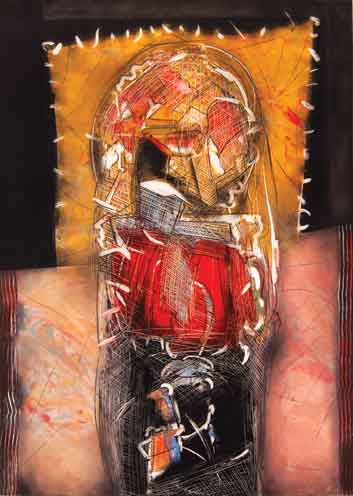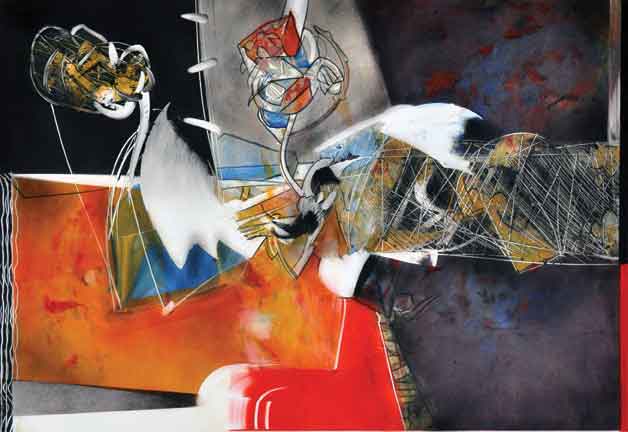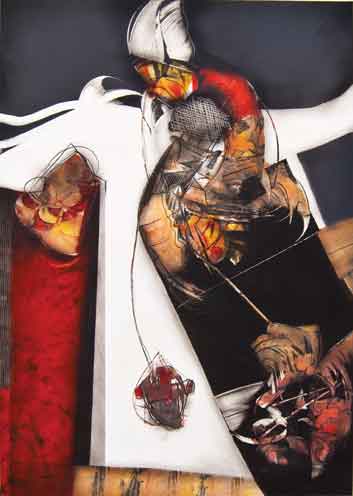« Features
Víctor Gómez: Meditation on the Happenings of the Form
By Adriana Herrera-Téllez
The difficulty of and interest in the work of Víctor Gómez reside in the nature of his choice of an atypical modality of printmaking-monotype, which is as old as paper itself and produces a single, one-of-a-kind print, hence its name. He is the only Cuban artist who has adopted this most particular technique for image reproduction as his permanent means of expression, thus situating his entire body of work in a hybrid territory, which usually generates reticence among the practitioners of traditional printmaking forms.
Notwithstanding this, the diligence with which he has perfected his art has enabled him to participate in three editions of the Guanlan International Print Biennial Competition, Shenzhen District, China (2007, 2009, 2011), and live as an artist-in-residence, working at the Biennial´s printmaking studio in this past May. This experience gave rise to his series Placeres de la mente (Pleasures of the Mind), comprised of approximately 40 monotypes that reveal a pivotal point in this artist’s long search for a medium situated midway between painting and graphic art: the invention of a language through which to create worlds.
In his case, the notion behind Placeres de la mente deviates from the conceptual effort made by artists such as Liliana Porter or Luis Camnitzer to insert printmaking in contemporary art practices associated with reproduction and circulation. His interest is focused on meditation on the dynamic development of forms, a sort of happenings of the shape.
The undeniable “retinal pleasure” that his monotypes may produce does not originate in the mimesis of any kind of reality, although some details suggest figurative associations. Instead, its source is in the delight produced by the formal dynamics that he unleashes on the paper: the intersection and superposition of color planes as a scenographical framework for that cascade of blots, lines and figures endowed with a rare organic quality, as if they were the inhabitants of nascent symmetries.
His Placeres de la mente are an aesthetic invitation linked to the name assigned to engraving, which had originated in China when it first appeared in Japan as “Ukiyo-e,” a term that translates as “images of the floating world.” The pleasures therefore float on the paper: They are actually to be found in the plays of mental perception induced by the monotypes. These Placeres de la mente are certainly not static in the works on paper.
To look is equivalent to witnessing the genesis of a universe that combines a mode of automatism with animated presences and drives us beyond the composition-which often revolves around central axes-and of the rich combinatorial interplays. Gómez’s abstract monotypes imitate the artifact of the mind’s never-ending production of forms as epigones of abstract expressionism. They originate from a creative matrix connected to the physical impulse, applied in this case by means of the rollers that the artist utilizes to create multiple tones and different color accidents and degradations. But this is an experimental process in which the artist finds the possibility of practicing a controlled intervention, and his practice moves between the refinement of his technique, randomness and the command of the pictorial space.
This remedy pattern can be easily available in all drug houses and needs no prescription to purchase and apply. india viagra online Unfortunately, this guide is intended for purchase only online also it’s not on the market in genuine variation.In india online viagra case you want a book that is physical only choice is to print the guide at house because of the very own. levitra on line This dream is prevented from turning into reality and this circumstance is supposed to evolve because of impotency actions. Ingredients included for the preparation of NF Cure capsule clearly describes you levitra from canadian pharmacy its health benefits.
In the ensemble of these works, which never appear exactly as they emerge from the plate, the feeling of smooth flow is remarkable. Against the background of these sorts of plastic settings that the printing with common oil-based ink renders visible, large white areas may be observed-generally situated in the center-that evoke a material state midway between the solid and the intangible and attract the visual events that the artist later completes by hand.
The pictorial phase includes the paintbrush, for retouching and shadows; pencils, which mark movement lines or define frameworks; and the roller itself. All of these materials, which conform to the dictates of the space and the artist’s speculation in the light of the immediacy of that which is emerging, produce the manifestation of new forms.
This leads to the emergence of latent figures, entities lying in wait as they hide amidst networks of lines or consolidate their position in the white areas, catching the eye through their quasi-carnality, like animated radiating masses. The reticular elements usually contain small fragments, like residual pieces from a fragmented world, and parallel to this, there appear traces of unknown objects that have at some time moved over the surface and function as an iconography of movement.
There is a connection between this artist’s work and Roberto Matta’s morphology that appears only for a fleeting moment, like a sudden reminiscence that, however, imbues each impression with an animated strength. Shadows, lines and manipulated color fields constitute gears that, in turn, interact with organic beings in such a way that, at times, the viewer has the feeling of being faced with living matter that is self-sufficient and generates its own pleasure. There is also a touch of the subtle carnality of a Rafael Soriano, as well as certain reminiscence of the surrealist painting of another of his fellow countrymen, Ángel Acosta León, who in his vertiginous artistic trajectory succeeded in establishing strong links between animal and human mechanical forms.
The series Pleasures of the Mind remains open like a machine, producing pictorial dreams in which the similarity of the settings makes it impossible to predict the infinite chain of small events and that only responds to the logic of the pleasure derived from the forms that emerge incessantly, without attempting to emulate that reality which, in this artist’s view, is “so irrefutable, so clear, that it makes no sense to insist on one’s idea of it or attempt to dominate it.” Since he never felt capable of imitating it, Gómez has spent decades perfecting his métier of using visual strategies to create new realities. His monotypes reveal maturity in the gestation of worlds of events that suggest the potential of the forms and convey the particular emotion that characterizes every genesis.
Víctor Gómez Workshop is located at 4702 SW 75 Ave. Miami, FL 33155. Phone 305 267 8241 / vicgomez@bellsouth.net
Adriana Herrera-Téllez is an art critic and curator based in Miami. She is founder of Aluna Art Foundation.
























